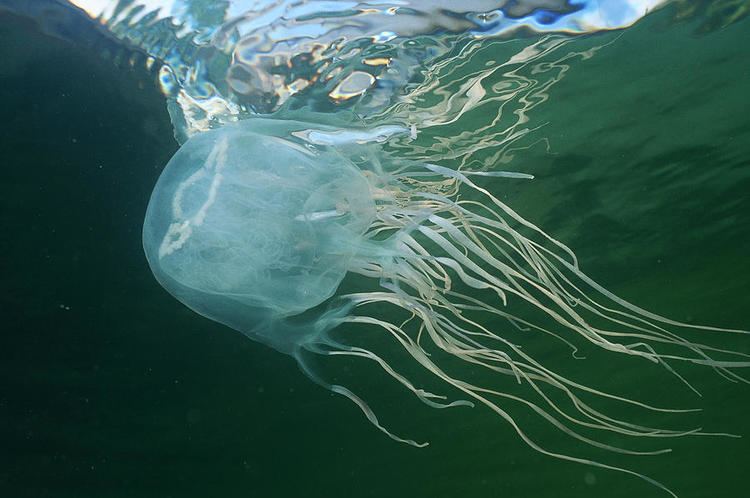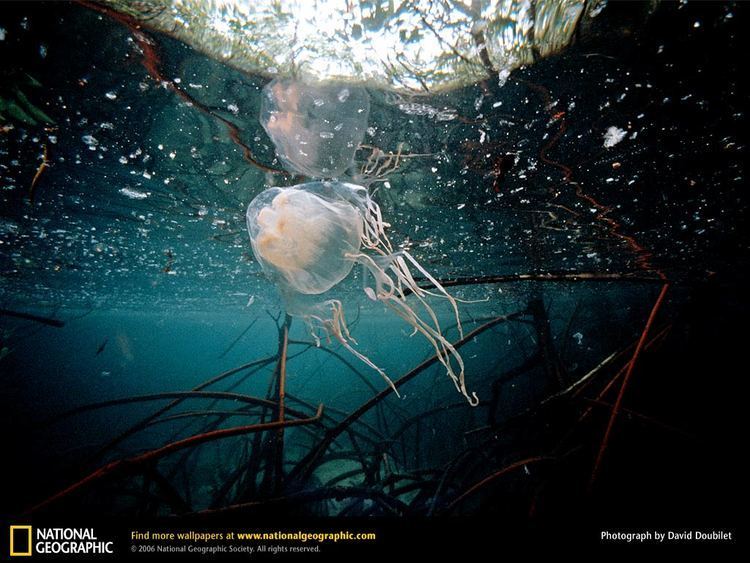Rank Species Higher classification Chironex | Scientific name Chironex fleckeri | |
 | ||
Similar Chironex, Box jellyfish, Portuguese man o' war, Carukia barnesi, Jellyfish | ||
Box jellyfish chironex fleckeri
Chironex fleckeri, commonly known as sea wasp, is a species of deadly venomous box jellyfish found in coastal waters from northern Australia and New Guinea north to the Philippines and Vietnam. It has been described as "the most lethal jellyfish in the world", with at least 63 known deaths in Australia from 1884 to 1996.
Contents
- Box jellyfish chironex fleckeri
- Name
- Description
- Distribution and habitat
- Sting
- History of sting treatment
- References

Notorious for its sting, C. fleckeri has tentacles up to 3 m (9.8 ft) long covered with millions of cnidocytes which, on contact, release microscopic darts delivering an extremely powerful venom. Being stung commonly results in excruciating pain, and if the sting area is significant, an untreated victim may die in two to five minutes. The amount of venom in one animal is said to be enough to kill 60 adult humans (although most stings are mild).

Box jellyfish chironex fleckeri
Name

Chironex fleckeri was named after North Queensland toxicologist and radiologist Doctor Hugo Flecker. "On January 20, 1955, when a 5-year-old boy died after being stung in shallow water at Cardwell, north Queensland, Flecker found three types of jellyfish. One of which was an unidentified: a box-shaped jellyfish with groups of tentacles arising from each corner. Flecker sent it to Dr Ronald Southcott in Adelaide, and on December 29, 1955, Southcott published his article introducing it as a new Genus and species of lethal box jellyfish. He named it Chironex fleckeri, the name being derived from the Greek `cheiro' meaning `hand', and the Latin `nex' meaning `murderer', and `fleckeri' in honour of its discoverer."
Description

Chironex fleckeri is the largest of the cubozoans (collectively called box jellyfish), many of which may carry similarly toxic venom. Its bell grows to about the size of a basketball. From each of the four corners of the bell trails a cluster of 15 tentacles. The pale blue bell has faint markings; viewed from certain angles, it bears a somewhat eerie resemblance to a human head or skull. Since it is virtually transparent, the creature is nearly impossible to see in its habitat, posing particular danger to swimmers.

When the jellyfish are swimming, the tentacles contract so they are about 15 cm long and about 5 mm in diameter; when they are hunting, the tentacles are thinner and extend to about 3 m long. The tentacles are covered with a high concentration of stinging cells called cnidocytes, which are activated by pressure and a chemical trigger; they react to proteinous chemicals. Box jellyfish are day hunters; at night they are seen resting on the ocean floor, apparently 'sleeping'. However, this 'sleeping' theory is still debated.
In common with other box jellyfish, C. fleckeri has four eye-clusters with 24 eyes. Some of these eyes seem capable of forming images, but whether they exhibit any object recognition or object tracking is debated; it is also unknown how they process information from their sense of touch and eye-like light-detecting structures due to their lack of a central nervous system. During a series of tests by marine biologists including Australian jellyfish expert Jamie Seymour, a single jellyfish was put in a tank. Then, two white poles were lowered into the tank. The creature appeared unable to see them and swam straight into them, thus knocking them over. Then, similar black poles were placed into the tank. This time, the jellyfish seemed aware of them, and swam around them in a figure-eight. Finally, to see if the specimen could see colour, a single red pole was stood in the tank. When the jellyfish apparently became aware of the object in its tank, it was seemingly repelled by it and remained at the far edge of the tank. Following these experiments, the Australian researchers put forward the idea of red safety nets for beaches (these nets are usually used to keep the jellyfish away, but many still get through its mesh). The test was repeated, with similar results, on Irukandji jellyfish, another toxic species of box jelly.
Chironex fleckeri lives on a diet of prawns and small fish, and are prey to turtles, whose thick skin is impenetrable to the cnidocytes of the jellyfish.
Distribution and habitat
The medusa is pelagic and has been documented from coastal waters of Australia and New Guinea north to the Philippines and Vietnam. In Australia, it is known from the northern coasts from Exmouth to Agnes Water, but its full distribution outside Australia has not been properly identified. To further confuse, the closely related and also dangerously venomous Chironex yamaguchii was first described from Japan in 2009. This species has also been documented from the Philippines, meaning the non-Australian records of C. fleckeri need to be rechecked. The jellyfish has also been known to inhabit freshwater.
Sting
Chironex fleckeri is best known for its extremely powerful and occasionally fatal "sting". The sting produces excruciating pain accompanied by an intense burning sensation, like being branded with a red hot iron. In Australia, fatalities are most often caused by the larger specimens of C. fleckeri.
In December 2012, Angel Yanagihara of the University of Hawaii's Department of Tropical Medicine found the venom causes cells to become porous enough to allow potassium leakage, causing hyperkalemia which can lead to cardiovascular collapse and death as quickly as within two to five minutes with an LD50 of 0.04 mg/kg, making it the most venomous jellyfish in the world (to laboratory mice). She postulated a zinc compound may be developed as an antidote. Occasionally, swimmers who get stung will undergo cardiac arrest or drown before they can even get back to the shore or boat.
If a person does manage to get to safety, treatment must be administered urgently. CPR may be required; for less serious stings, treatment with ice packs and antihistamines is an effective method of pain relief. Adhering tentacles should be removed carefully from the skin using protected hands or tweezers. Removed tentacles remain capable of stinging until broken down by time, and even dried and presumably dead tentacles can be reactivated if wet.
An antivenom to the box jellyfish's sting does exist. After the immediate treatment described above, it must be administered quickly. Hospitals and ambulance services near to where the jellyfish live possess it, and must be contacted as soon as possible. The jellyfish's venom is so powerful, however, that even if the victims get to safety and have the immediate treatment given, they may die before an ambulance can reach them.
In Australia, C. fleckeri has caused at least 64 deaths since the first report in 1883, but most encounters appear to result only in mild envenomation. Most recent deaths have been children, as their smaller body mass puts them at a higher risk of fatal envenomation.
Chironex fleckeri and other jellyfish, including the Irukandji (Carukia barnesi), are abundant in the waters of northern Australia during the summer months (November to April or May). They are believed to drift into the aforementioned estuaries to breed. Signs like the one pictured are erected along the coast of North Queensland to warn people of such, and few people swim during this period. Some people still do, however, putting themselves at great risk. At popular swimming spots, net enclosures are placed out in the water wherein people can swim but jellyfish cannot get in, keeping swimmers safe.
History of sting treatment
Until 2005, treatment involved using pressure immobilisation bandages, with the aim of preventing distribution of the venom through the lymph and blood circulatory systems. This treatment is no longer recommended by health authorities, due to research which showed that using bandages to achieve tissue compression provoked nematocyst discharge.
The application of vinegar is recommended treatment because vinegar (4-6% acetic acid) permanently deactivates undischarged nematocysts, preventing them from opening and releasing venom. A 2014 study demonstrated in vitro that while vinegar deactivates unfired nematocysts, there was also an increase in venom concentration in the solution, possibly by causing already-fired nematocysts (which still contain some venom) to release what remained. However, this study has been criticized on several methodological grounds, including that the experiment was done using a model membrane that is much different (and more simple) than human skin. Also, the researchers did not determine whether the increase in venom concentration was caused by already-discharged nematocysts releasing more venom, or if the venom that was released initially had simply leaked back out through the membrane, thus confounding the concentration measurement. Despite these concerns, dilute acetic acid is still the recommended treatment.
